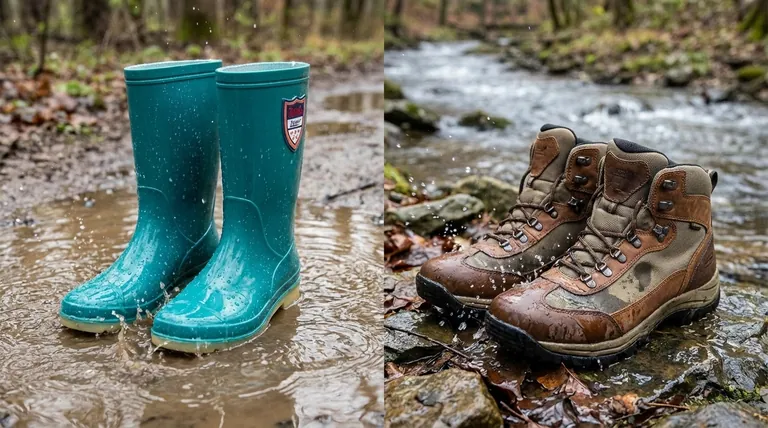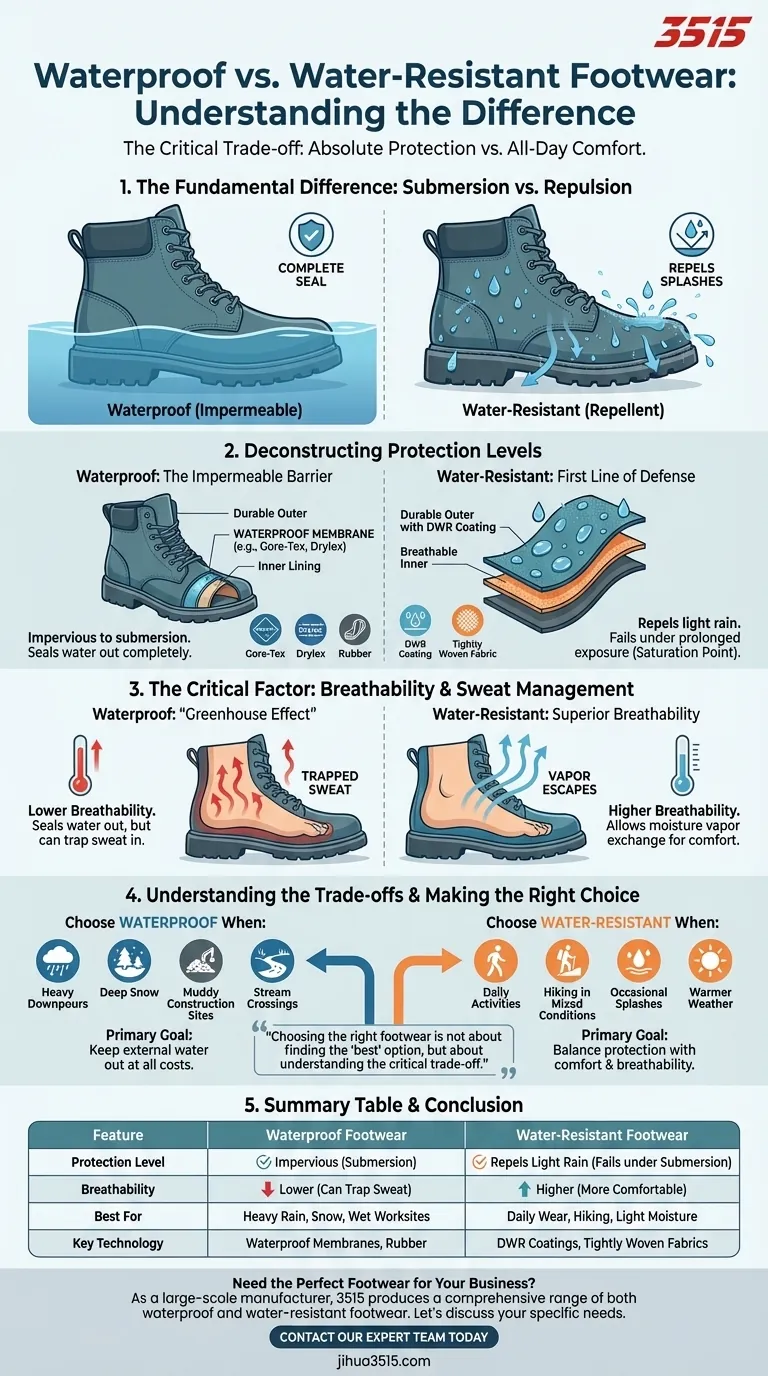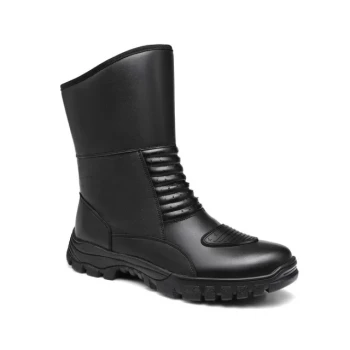The fundamental difference between waterproof and water-resistant footwear lies in their ability to handle submersion. Waterproof footwear is engineered to be completely impervious to water, even when fully submerged for extended periods. Water-resistant footwear can repel water from splashes or light rain but will eventually allow moisture to penetrate under prolonged exposure or submersion.
Choosing the right footwear is not about finding the "best" option, but about understanding the critical trade-off between absolute water protection and all-day comfort. Waterproofing seals water out, but it can also seal sweat in.

Deconstructing the Levels of Protection
The terms "waterproof" and "water-resistant" represent two distinct engineering goals. Understanding their construction reveals their intended use and performance limits.
Waterproof: The Impermeable Barrier
Truly waterproof footwear is designed to create a complete, impenetrable seal against moisture. This means it can be submerged in puddles, streams, or heavy rain without allowing any water to reach your foot.
This level of protection is typically achieved using a waterproof membrane, like Gore-Tex or Drylex, which is a layer built into the shoe's construction. It can also be achieved with inherently non-porous materials like rubber.
Water-Resistant: The First Line of Defense
Water-resistant footwear is treated to repel water upon contact, but only up to a certain point. The materials and construction are not designed to be a perfect seal.
These shoes and boots will effectively keep your feet dry from splashes, dewy grass, or a light drizzle. However, once the material reaches its saturation point from heavy rain or standing in water, moisture will begin to seep through.
A Note on "Water-Repellent"
The term water-repellent is often used interchangeably with water-resistant. It typically describes a coating applied to the exterior fabric that causes water to bead up and roll off, preventing the material from becoming saturated quickly. This is a feature of most water-resistant footwear.
The Critical Factor: Breathability
The most significant trade-off between these two types of footwear is not just water protection, but breathability—the ability for sweat vapor to escape.
The Waterproof "Greenhouse Effect"
By sealing water out, waterproof membranes and materials inherently make it more difficult for the moisture your feet produce to escape. This can lead to a "greenhouse effect" inside your shoe.
Even if no external water gets in, your feet can become damp and uncomfortable from trapped sweat, especially during strenuous activity.
The Comfort of Water-Resistance
Water-resistant footwear, lacking a complete membrane, allows for significantly more air and moisture vapor exchange.
This superior breathability means your feet will stay drier from sweat, making them a more comfortable choice for high-exertion activities or use in warmer, less severe conditions.
Understanding the Trade-offs
Neither technology is universally superior. The correct choice depends entirely on your environment and activity level. Choosing the wrong one can lead to discomfort or inadequate protection.
The Case for Waterproof
Waterproof footwear is the only reliable choice when you expect prolonged exposure to significant moisture. Think heavy downpours, deep snow, muddy construction sites, or stream crossings. The primary goal here is to keep external water out at all costs.
When Water-Resistant Is the Smarter Choice
For most daily activities, hiking in mixed conditions, or working in environments with occasional splashes, water-resistant footwear often provides a better balance. It offers sufficient protection while prioritizing the comfort that comes from enhanced breathability.
Making the Right Choice for Your Goal
Select your footwear based on the most demanding conditions you realistically expect to face.
- If your primary focus is working in consistently wet environments: Choose truly waterproof footwear to guarantee your feet stay dry from rain, puddles, and standing water.
- If your primary focus is hiking or all-day wear in varied weather: Water-resistant footwear provides a superior balance of protection and breathability, preventing discomfort from sweat.
- If your primary focus is everyday use with a chance of light rain or splashes: A water-resistant shoe is more than sufficient and will be significantly more comfortable than a fully waterproof option.
Ultimately, understanding this distinction empowers you to select footwear that truly serves your purpose, keeping you comfortable and protected.
Summary Table:
| Feature | Waterproof Footwear | Water-Resistant Footwear |
|---|---|---|
| Protection Level | Impervious to water, even when submerged | Repels light rain/splashes; fails under submersion |
| Breathability | Lower (can trap sweat) | Higher (more comfortable for active use) |
| Best For | Heavy rain, deep snow, wet worksites | Daily wear, hiking in mixed conditions, light moisture |
| Key Technology | Waterproof membranes (e.g., Gore-Tex), rubber | DWR coatings, tightly woven fabrics |
Need the Perfect Footwear for Your Business?
As a large-scale manufacturer, 3515 produces a comprehensive range of both waterproof and water-resistant footwear for distributors, brand owners, and bulk clients. Our production capabilities encompass all types of shoes and boots, ensuring you get the right balance of protection, comfort, and durability for your target market.
Let's discuss your specific needs and how we can deliver high-quality footwear solutions for you.
Contact our expert team today to get started!
Visual Guide

Related Products
- Factory Direct Wholesale Rain Boots Durable Waterproof & Fully Customizable
- Safety Footwear Wholesale Manufacturer for Custom OEM/ODM Production
- Wholesale Waterproof Tactical Boots Custom Suede & High-Traction Soles
- Premium Wholesale Waterproof Safety Boots High Performance Protection for Industrial Markets
- High Performance Fire-Retardant Waterproof Safety Boots
People Also Ask
- What variety of rubber boots is available? From Rain to Safety and Medical Solutions
- What are the key characteristics of rain boots? Essential Features for Total Dryness
- What are the main materials used in the production of rain boots? A Guide to Durability & Comfort
- What factors should be considered when choosing rain boots? Find the Perfect Boot for Your Needs
- What are the limitations of rain boots in certain climates? Find the Right Footwear for Your Weather



















